String Instruments
Used on the CDs
Bowed String Instruments
 Violin,
the standard
bowed four-string instrument, tuned
(thick to thin string) in ascending perfect fifths starting
on G below middle C up to D, then A and E.
String length is around 13 inches. Same tuning as the standard
mandolin, so the violin and mandolin fingerings are the same.
This instrument was made in 1800. I bought this from my violin
teacher, Charles Treger, who endured my violin playing for six years in
college.
Violin,
the standard
bowed four-string instrument, tuned
(thick to thin string) in ascending perfect fifths starting
on G below middle C up to D, then A and E.
String length is around 13 inches. Same tuning as the standard
mandolin, so the violin and mandolin fingerings are the same.
This instrument was made in 1800. I bought this from my violin
teacher, Charles Treger, who endured my violin playing for six years in
college.
 Viola:
the standard
bowed four-string instrument, larger than a violin,
with string length around 16 inches, and tuned h (thick to
thin strings) in ascending perfect fifths from C below middle C
up to G, then D and A. This is a perfect fifth lower than
the violin, and tuned the same as a mandola. So the viola and
mandola fingerings are the same. This student model instrument
was made a few years ago in China.
Viola:
the standard
bowed four-string instrument, larger than a violin,
with string length around 16 inches, and tuned h (thick to
thin strings) in ascending perfect fifths from C below middle C
up to G, then D and A. This is a perfect fifth lower than
the violin, and tuned the same as a mandola. So the viola and
mandola fingerings are the same. This student model instrument
was made a few years ago in China.

Cello: the standard
bowed four-string instrument, tuned (thick to thin strings) in
ascending perfect fifths from
C two octaves below middle C up to G, then up to D and A.
The string length is around 26 inches. This
is an octave below the viola, and tuned the same as the
mandocello. So the cello and mandocello fingering is the
same. This is a student model instrument made in China.
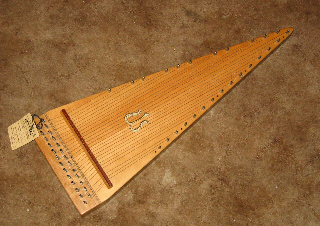 Psaltery. We
used a standard psaltery and a tenor
psaltery.
They are both chromatic. The tenor ranges from F to an F two
octaves higher. It's played with a bow. The natural notes
are on the right side and the sharp and flat notes are on the left
side.
This instrument came from Elderly Instruments.
Psaltery. We
used a standard psaltery and a tenor
psaltery.
They are both chromatic. The tenor ranges from F to an F two
octaves higher. It's played with a bow. The natural notes
are on the right side and the sharp and flat notes are on the left
side.
This instrument came from Elderly Instruments.
Struck or Plucked String Instruments
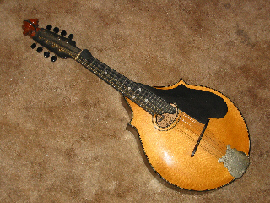 Mandolin: this one
was made by Washburn in the 1920s. Mandolins have four pairs of
strings. Both strings in each pair are on the same pitch.
Tuned from low to high (thick to thin) G, D, A and E, just like a
violin. So, the mandolin has the same fingering as a
violin. Played with a pick. I got this in a trade years ago
up in Iowa.
Mandolin: this one
was made by Washburn in the 1920s. Mandolins have four pairs of
strings. Both strings in each pair are on the same pitch.
Tuned from low to high (thick to thin) G, D, A and E, just like a
violin. So, the mandolin has the same fingering as a
violin. Played with a pick. I got this in a trade years ago
up in Iowa.
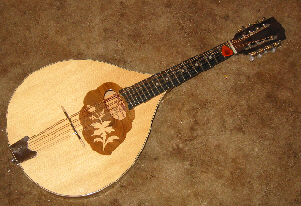
Mandola: This one was
made in eastern Europe. It has four
pairs of strings. Both strings in each pair are on the same
pitch, like a mandolin. They are tuned low-to-high (thick
to thin strings) C, G, D and A, just like a viola. String length is
around 16 inches. So mandola and viola have the same fingering.
Mandola is played with a pick.
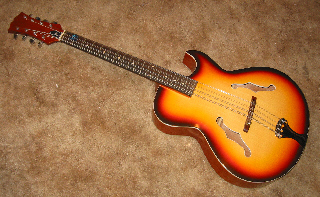 Mandocello: This one
was recently built in the N.E. part of the U.S. It has four pairs of
strings. Both
strings in each pair are on the same pitch. Low to high (thick to
thin) they are tuned C, G, D and A, but an octave lower than the
mandola, so same tuning as a cello. The mandocello as the same
fingering as a cello. String length is around 26 inches.
This instrument is played with a pick.
Mandocello: This one
was recently built in the N.E. part of the U.S. It has four pairs of
strings. Both
strings in each pair are on the same pitch. Low to high (thick to
thin) they are tuned C, G, D and A, but an octave lower than the
mandola, so same tuning as a cello. The mandocello as the same
fingering as a cello. String length is around 26 inches.
This instrument is played with a pick.
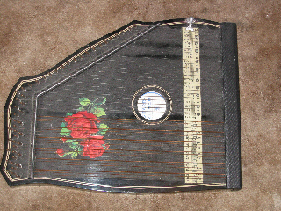 Chromatic guitar
Zither: this instrument was made in Germany. It has six
chords
(C, G, F, d minor, a minor, e minor) and two chromatic octaves of
melody strings, starting at a C. This instrument is larger
than the diatonic guitar zither I have and the bass end is much
better. My old garage sale buddy found this at a thrift
shop here in town.
Chromatic guitar
Zither: this instrument was made in Germany. It has six
chords
(C, G, F, d minor, a minor, e minor) and two chromatic octaves of
melody strings, starting at a C. This instrument is larger
than the diatonic guitar zither I have and the bass end is much
better. My old garage sale buddy found this at a thrift
shop here in town.
Tuning tool:
The psalteries, guitar zithers, Austrian zither and autoharp all use
the same tuning tool. I believe that also carries over to the
Appalacian Dulcimer, but I don't have one to try it on.
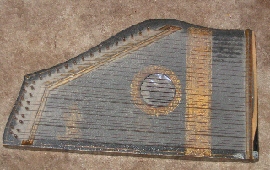 Diatonic
Zither: this is early 1900s or before. It has four
chords:
C, F, G and a minor, and two diatonic (white keys only) octaves of
melody notes beginning at a C. Neither of these is a real
"zither". A real zither has a fretted area with five strings, and
then a collection of many other accompanyment and bass
strings. My great aunt gave me this instrument when I was in
grade school.
Diatonic
Zither: this is early 1900s or before. It has four
chords:
C, F, G and a minor, and two diatonic (white keys only) octaves of
melody notes beginning at a C. Neither of these is a real
"zither". A real zither has a fretted area with five strings, and
then a collection of many other accompanyment and bass
strings. My great aunt gave me this instrument when I was in
grade school.
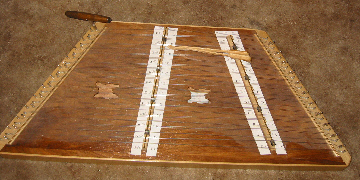 Hammer
Dulcimer: This is a student model built in Bransen, MO by
Butterfly. It is a 12/11 course instrument. Lowest string
is a G. I have a cheat sheet on the instrument so it's easier to
find the notes. The left bridge splits the strings going over it
so that the left (shorter) portion is a perfect fifth higher than the
right (longer) portion..... ie, the left portion is 2/3 the length of
the right portion. The right bridge splits the other strings
going over it so that the right portion is two octaves higher
than the left portion.... ie, the right portion is 1/4 the length
of the left portion. The strings going over the left bridge go
through holes in the right bridge, and visa versa.
Hammer
Dulcimer: This is a student model built in Bransen, MO by
Butterfly. It is a 12/11 course instrument. Lowest string
is a G. I have a cheat sheet on the instrument so it's easier to
find the notes. The left bridge splits the strings going over it
so that the left (shorter) portion is a perfect fifth higher than the
right (longer) portion..... ie, the left portion is 2/3 the length of
the right portion. The right bridge splits the other strings
going over it so that the right portion is two octaves higher
than the left portion.... ie, the right portion is 1/4 the length
of the left portion. The strings going over the left bridge go
through holes in the right bridge, and visa versa.
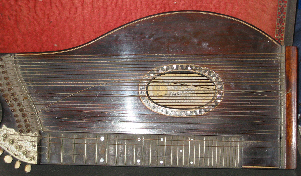 Austrian zither: I need to buy a new set of
strings
for this one. It should have five strings over the fret board,
and around 26 other strings, I believe, mostly arranged in groups
of three, where each group forms a major chord. This is the
only instrument on this page that we have not used yet on a Christmas
CD. It looks
like a very challenging instrument to play. This one was made in
Missouri.
Austrian zither: I need to buy a new set of
strings
for this one. It should have five strings over the fret board,
and around 26 other strings, I believe, mostly arranged in groups
of three, where each group forms a major chord. This is the
only instrument on this page that we have not used yet on a Christmas
CD. It looks
like a very challenging instrument to play. This one was made in
Missouri.
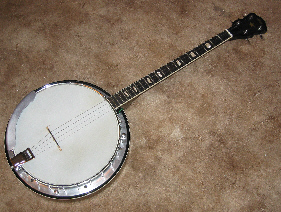 Tenor Banjo: an Iida
banjo, tuned just like a viola low-to-high (thick to thin string)
is C, G, D and A. This is just like a viola, or a mandola only
the string length is around 22 inches. So, if you have very big
hands you can finger it like a viola, otherwise, like me, you
need to finger it like a cello to avoid total confusion.
It is played with a pick.
Tenor Banjo: an Iida
banjo, tuned just like a viola low-to-high (thick to thin string)
is C, G, D and A. This is just like a viola, or a mandola only
the string length is around 22 inches. So, if you have very big
hands you can finger it like a viola, otherwise, like me, you
need to finger it like a cello to avoid total confusion.
It is played with a pick.
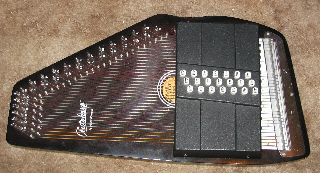 Autoharp: This one
has 21 buttons and is an old Oscar Schmidt autoharp that I bought on
ebay. The buttons make chords by muting all strings that do not
belong in that chord and allowing the others to sound when
plucked. There are three rows of buttons. These buttons are
generally in circle-of-fifths order in each row. One row
generally has major chords, middle row has major seventh chords, and
the last row has minor chords. This rule falls apart at the ends
of each row however. You play with either a felt pick or thumb
and finger picks. It's best to hold the instrument up against you
instead of placing it on a table to play it. Basically it
has a two octave range in the melody area of the instrument, and will
handle keys ranging from E-flat to A, if the song doesn't stray too far
through the circle of fifths. I've also seen models having 12, 15
and 18 buttons. I have a 12 button autoharp but not an Oscar
Schmidt.
Autoharp: This one
has 21 buttons and is an old Oscar Schmidt autoharp that I bought on
ebay. The buttons make chords by muting all strings that do not
belong in that chord and allowing the others to sound when
plucked. There are three rows of buttons. These buttons are
generally in circle-of-fifths order in each row. One row
generally has major chords, middle row has major seventh chords, and
the last row has minor chords. This rule falls apart at the ends
of each row however. You play with either a felt pick or thumb
and finger picks. It's best to hold the instrument up against you
instead of placing it on a table to play it. Basically it
has a two octave range in the melody area of the instrument, and will
handle keys ranging from E-flat to A, if the song doesn't stray too far
through the circle of fifths. I've also seen models having 12, 15
and 18 buttons. I have a 12 button autoharp but not an Oscar
Schmidt.
 Guitar:
This is a Honer large body acoustic guitar, made in Korea, I
think. I have used it on a few tracks, in standard tuning.
Guitar:
This is a Honer large body acoustic guitar, made in Korea, I
think. I have used it on a few tracks, in standard tuning.
Wind Instruments
Mike brought his standard flute and his alto flute, and a soprano
recorder and tenor recorders, and we used my alto recorder.
Keyboards
MIDI keyboard, first a caseo five octave keyboard with MIDI IN and MIDI
OUT, then a yamaha 88-key keyboard with USB interface. Some of
the MIDI sounds, especially the tubular bells, are produced by the
sound card, not the keyboard. The sound card I was using is a
Creative labs PCI-128.
Song Spinner Records Home Page
 Violin
Violin Violin,
the standard
bowed four-string instrument, tuned
(thick to thin string) in ascending perfect fifths starting
on G below middle C up to D, then A and E.
String length is around 13 inches. Same tuning as the standard
mandolin, so the violin and mandolin fingerings are the same.
This instrument was made in 1800. I bought this from my violin
teacher, Charles Treger, who endured my violin playing for six years in
college.
Violin,
the standard
bowed four-string instrument, tuned
(thick to thin string) in ascending perfect fifths starting
on G below middle C up to D, then A and E.
String length is around 13 inches. Same tuning as the standard
mandolin, so the violin and mandolin fingerings are the same.
This instrument was made in 1800. I bought this from my violin
teacher, Charles Treger, who endured my violin playing for six years in
college.  Viola:
the standard
bowed four-string instrument, larger than a violin,
with string length around 16 inches, and tuned h (thick to
thin strings) in ascending perfect fifths from C below middle C
up to G, then D and A. This is a perfect fifth lower than
the violin, and tuned the same as a mandola. So the viola and
mandola fingerings are the same. This student model instrument
was made a few years ago in China.
Viola:
the standard
bowed four-string instrument, larger than a violin,
with string length around 16 inches, and tuned h (thick to
thin strings) in ascending perfect fifths from C below middle C
up to G, then D and A. This is a perfect fifth lower than
the violin, and tuned the same as a mandola. So the viola and
mandola fingerings are the same. This student model instrument
was made a few years ago in China. 
 Psaltery. We
used a standard psaltery and a tenor
psaltery.
They are both chromatic. The tenor ranges from F to an F two
octaves higher. It's played with a bow. The natural notes
are on the right side and the sharp and flat notes are on the left
side.
This instrument came from Elderly Instruments.
Psaltery. We
used a standard psaltery and a tenor
psaltery.
They are both chromatic. The tenor ranges from F to an F two
octaves higher. It's played with a bow. The natural notes
are on the right side and the sharp and flat notes are on the left
side.
This instrument came from Elderly Instruments. Mandolin: this one
was made by Washburn in the 1920s. Mandolins have four pairs of
strings. Both strings in each pair are on the same pitch.
Tuned from low to high (thick to thin) G, D, A and E, just like a
violin. So, the mandolin has the same fingering as a
violin. Played with a pick. I got this in a trade years ago
up in Iowa.
Mandolin: this one
was made by Washburn in the 1920s. Mandolins have four pairs of
strings. Both strings in each pair are on the same pitch.
Tuned from low to high (thick to thin) G, D, A and E, just like a
violin. So, the mandolin has the same fingering as a
violin. Played with a pick. I got this in a trade years ago
up in Iowa.
 Mandocello: This one
was recently built in the N.E. part of the U.S. It has four pairs of
strings. Both
strings in each pair are on the same pitch. Low to high (thick to
thin) they are tuned C, G, D and A, but an octave lower than the
mandola, so same tuning as a cello. The mandocello as the same
fingering as a cello. String length is around 26 inches.
This instrument is played with a pick.
Mandocello: This one
was recently built in the N.E. part of the U.S. It has four pairs of
strings. Both
strings in each pair are on the same pitch. Low to high (thick to
thin) they are tuned C, G, D and A, but an octave lower than the
mandola, so same tuning as a cello. The mandocello as the same
fingering as a cello. String length is around 26 inches.
This instrument is played with a pick. Chromatic guitar
Zither: this instrument was made in Germany. It has six
chords
(C, G, F, d minor, a minor, e minor) and two chromatic octaves of
melody strings, starting at a C. This instrument is larger
than the diatonic guitar zither I have and the bass end is much
better. My old garage sale buddy found this at a thrift
shop here in town.
Chromatic guitar
Zither: this instrument was made in Germany. It has six
chords
(C, G, F, d minor, a minor, e minor) and two chromatic octaves of
melody strings, starting at a C. This instrument is larger
than the diatonic guitar zither I have and the bass end is much
better. My old garage sale buddy found this at a thrift
shop here in town. Diatonic
Zither: this is early 1900s or before. It has four
chords:
C, F, G and a minor, and two diatonic (white keys only) octaves of
melody notes beginning at a C. Neither of these is a real
"zither". A real zither has a fretted area with five strings, and
then a collection of many other accompanyment and bass
strings. My great aunt gave me this instrument when I was in
grade school.
Diatonic
Zither: this is early 1900s or before. It has four
chords:
C, F, G and a minor, and two diatonic (white keys only) octaves of
melody notes beginning at a C. Neither of these is a real
"zither". A real zither has a fretted area with five strings, and
then a collection of many other accompanyment and bass
strings. My great aunt gave me this instrument when I was in
grade school. Hammer
Dulcimer: This is a student model built in Bransen, MO by
Butterfly. It is a 12/11 course instrument. Lowest string
is a G. I have a cheat sheet on the instrument so it's easier to
find the notes. The left bridge splits the strings going over it
so that the left (shorter) portion is a perfect fifth higher than the
right (longer) portion..... ie, the left portion is 2/3 the length of
the right portion. The right bridge splits the other strings
going over it so that the right portion is two octaves higher
than the left portion.... ie, the right portion is 1/4 the length
of the left portion. The strings going over the left bridge go
through holes in the right bridge, and visa versa.
Hammer
Dulcimer: This is a student model built in Bransen, MO by
Butterfly. It is a 12/11 course instrument. Lowest string
is a G. I have a cheat sheet on the instrument so it's easier to
find the notes. The left bridge splits the strings going over it
so that the left (shorter) portion is a perfect fifth higher than the
right (longer) portion..... ie, the left portion is 2/3 the length of
the right portion. The right bridge splits the other strings
going over it so that the right portion is two octaves higher
than the left portion.... ie, the right portion is 1/4 the length
of the left portion. The strings going over the left bridge go
through holes in the right bridge, and visa versa. Austrian zither: I need to buy a new set of
strings
for this one. It should have five strings over the fret board,
and around 26 other strings, I believe, mostly arranged in groups
of three, where each group forms a major chord. This is the
only instrument on this page that we have not used yet on a Christmas
CD. It looks
like a very challenging instrument to play. This one was made in
Missouri.
Austrian zither: I need to buy a new set of
strings
for this one. It should have five strings over the fret board,
and around 26 other strings, I believe, mostly arranged in groups
of three, where each group forms a major chord. This is the
only instrument on this page that we have not used yet on a Christmas
CD. It looks
like a very challenging instrument to play. This one was made in
Missouri. Tenor Banjo: an Iida
banjo, tuned just like a viola low-to-high (thick to thin string)
is C, G, D and A. This is just like a viola, or a mandola only
the string length is around 22 inches. So, if you have very big
hands you can finger it like a viola, otherwise, like me, you
need to finger it like a cello to avoid total confusion.
It is played with a pick.
Tenor Banjo: an Iida
banjo, tuned just like a viola low-to-high (thick to thin string)
is C, G, D and A. This is just like a viola, or a mandola only
the string length is around 22 inches. So, if you have very big
hands you can finger it like a viola, otherwise, like me, you
need to finger it like a cello to avoid total confusion.
It is played with a pick.  Autoharp: This one
has 21 buttons and is an old Oscar Schmidt autoharp that I bought on
ebay. The buttons make chords by muting all strings that do not
belong in that chord and allowing the others to sound when
plucked. There are three rows of buttons. These buttons are
generally in circle-of-fifths order in each row. One row
generally has major chords, middle row has major seventh chords, and
the last row has minor chords. This rule falls apart at the ends
of each row however. You play with either a felt pick or thumb
and finger picks. It's best to hold the instrument up against you
instead of placing it on a table to play it. Basically it
has a two octave range in the melody area of the instrument, and will
handle keys ranging from E-flat to A, if the song doesn't stray too far
through the circle of fifths. I've also seen models having 12, 15
and 18 buttons. I have a 12 button autoharp but not an Oscar
Schmidt.
Autoharp: This one
has 21 buttons and is an old Oscar Schmidt autoharp that I bought on
ebay. The buttons make chords by muting all strings that do not
belong in that chord and allowing the others to sound when
plucked. There are three rows of buttons. These buttons are
generally in circle-of-fifths order in each row. One row
generally has major chords, middle row has major seventh chords, and
the last row has minor chords. This rule falls apart at the ends
of each row however. You play with either a felt pick or thumb
and finger picks. It's best to hold the instrument up against you
instead of placing it on a table to play it. Basically it
has a two octave range in the melody area of the instrument, and will
handle keys ranging from E-flat to A, if the song doesn't stray too far
through the circle of fifths. I've also seen models having 12, 15
and 18 buttons. I have a 12 button autoharp but not an Oscar
Schmidt. Guitar:
This is a Honer large body acoustic guitar, made in Korea, I
think. I have used it on a few tracks, in standard tuning.
Guitar:
This is a Honer large body acoustic guitar, made in Korea, I
think. I have used it on a few tracks, in standard tuning.